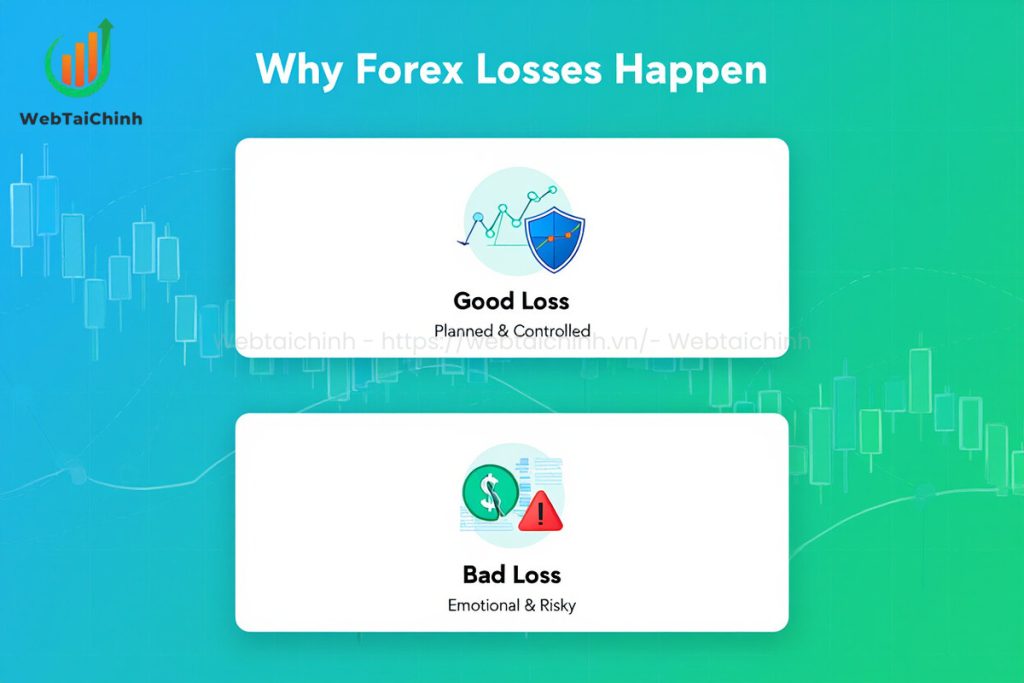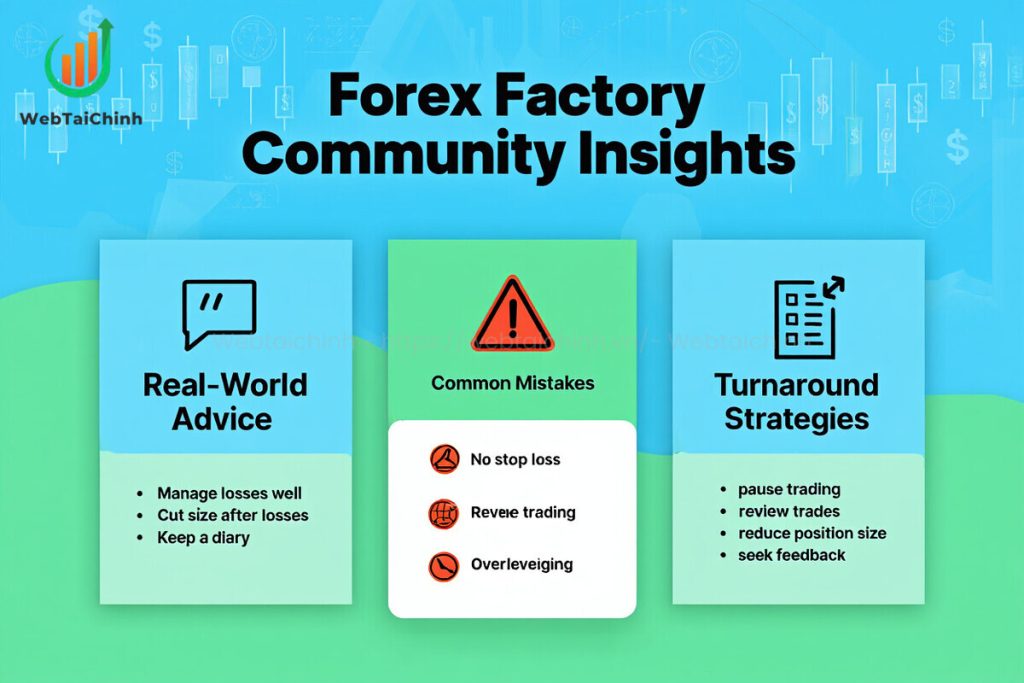Physical Address
304 North Cardinal St.
Dorchester Center, MA 02124
Physical Address
304 North Cardinal St.
Dorchester Center, MA 02124

How to deal with losses forex factory – Have you ever felt frustrated after a losing trade and wondered if you could handle it better? Losses in forex are inevitable, but they don’t have to destroy your confidence or your capital. The truth is, even the most successful traders face setbacks, and what separates them from the rest is how they respond.
In this guide, you’ll learn practical strategies and psychological tools backed by real discussions from Forex Factory to turn losses into lessons, protect your account, and bounce back stronger. Start your journey toward more disciplined trading with Webtaichinh.
Key takeaways:
Losses are a normal part of trading, and understanding how to deal with losses forex factory starts with knowing why they occur. In forex, even a well-planned trade can result in a loss due to market uncertainty. The key is distinguishing between a “good” loss one that follows your trading rules and a “bad” loss caused by impulsive or emotional decisions.

Good loss: Happens when a trade hits your stop-loss as part of a tested strategy. It’s controlled, expected, and helps you stick to your plan.
Bad loss: Comes from ignoring risk management, chasing the market, or trading based on emotions. These losses often cause bigger account damage.
Market volatility – Sudden price swings can trigger stop-loss orders unexpectedly.
News events – Economic announcements or geopolitical developments can cause sharp, unpredictable moves.
Lack of tested strategy – Trading without a proven method leads to inconsistent results.
Over-leverage – Using excessive leverage magnifies losses beyond manageable levels.
Emotional trading – Fear, greed, or frustration can lead to poor decision-making.
Example: A disciplined trader places a stop-loss below a strong support level but still loses when an unexpected interest rate hike shocks the market a good loss. Another trader, frustrated after two losses, doubles their position size without analysis and wipes out a large part of their account a bad loss.
If you want to master how to deal with losses forex factory, applying strong, consistent strategies is essential. Risk management tools protect your capital, while a disciplined trading plan keeps emotions in check and prevents costly mistakes.

Stop-loss types & placement strategy
Standard stop-loss: Fixed level to exit when price moves against you.
Guaranteed stop-loss: Broker ensures exit at the exact price, even in volatile markets.
Trailing stop-loss: Moves with price to lock in profits while limiting losses.
Placement tip: Adjust stop-loss levels based on volatility and key support/resistance zones to avoid premature exits.
Position sizing (1–2% rule) & diversification
Risk only 1–2% of your account per trade.
Use a position sizing formula:
Position Size = (Account Risk $) ÷ (Stop-Loss in Pips × Pip Value)
Spread trades across uncorrelated currency pairs to reduce total exposure.
Risk-reward ratios (minimum 1:2)
Aim for setups where potential profit is at least twice the potential loss.
Example: Risking 50 pips for a possible 100-pip gain is solid; risking 50 pips for 40 pips is not worth it.
Read more about risk : what is considered the greatest risk associated with forex settlement
Account drawdown limits & trading breaks
Daily limit: e.g., 3% of account.
Weekly limit: e.g., 6%.
Max total drawdown: e.g., 15%.
Stop trading once limits are hit to reset mentally and avoid revenge trading.
A robust trading plan acts as your decision-making map, reducing guesswork and emotional reactions. Key components include:
Clear entry & exit rules based on tested strategies.
Risk management rules for stop-loss, position size, and leverage.
Emotional guidelines to prevent fear or greed-driven trades.
Review schedule to adjust your plan based on performance data.
Tip from Forex Factory: Traders who strictly follow a documented plan report fewer impulsive trades and more consistent results, even during losing streaks.
Even with solid risk management, trading success depends heavily on your mental state. Many traders on Forex Factory agree that mastering psychology is the most challenging and most rewarding part of how to deal with losses forex factory.

Common trading emotions include:
Fear – Leads to premature exits or avoiding good setups.
Greed – Makes you overstay in winning trades or overleverage.
FOMO (Fear of Missing Out) – Causes you to enter late in trends.
Frustration – Often triggers revenge trading.
Control techniques:
Pause before placing trades and re-check your analysis.
Use deep breathing or mindfulness meditation to stay calm.
Keep a short checklist to confirm trade logic before execution.
Reframe losses as feedback rather than failure.
Good losses confirm that your stop-loss and risk rules work.
Bad losses highlight areas for improvement either in strategy or discipline.
Avoid falling into denial, blaming the market, or doubling down on risk to recover quickly. Instead, document each loss in your journal with the setup, emotional state, and key lesson learned.
Resilient traders bounce back from setbacks without losing focus.
Maintain a trade journal to track patterns and results.
Take scheduled breaks to avoid burnout.
Engage with trading peers for feedback and emotional support.
Keep healthy routines outside of trading exercise, hobbies, balanced lifestyle.
Forex Factory insight: Many traders report that adding non-trading activities to their schedule helps them maintain clarity and avoid overtrading during volatile periods.
Learning how to deal with losses forex factory becomes easier when you draw from the experience of seasoned traders. On the forums, members share candid stories and strategies for turning setbacks into stepping stones.

“Losses are part of the game. The goal is not to avoid them, but to manage them well.” – Veteran Forex Factory member.
“After three losses, I cut my position size in half and took a break. That saved my account.” – Long-term trader in a community thread.
“Keeping a trading diary is non-negotiable for me. It shows patterns I can’t see in the heat of the moment.” – Forum contributor.
Ignoring stop-loss settings during volatile news.
Revenge trading after a losing streak.
Overleveraging to recover losses quickly.
Pause trading for a set period after hitting a drawdown limit.
Review recent trades objectively, looking for recurring errors.
Reduce position size until consistency returns.
Engage with the community to get unbiased feedback.
Key takeaway: The collective wisdom from Forex Factory emphasizes discipline, emotional detachment, and a structured approach to loss recovery. These principles align with everything discussed in the earlier sections and form the backbone of sustainable trading.
A quick guide for traders mastering how to deal with losses forex factory:
Set a stop-loss for every trade.
Risk only 1–2% of account per trade.
Keep risk-reward at least 1:2.
Stop trading when drawdown limits are hit.
Log losses immediately in a journal.
Review and adjust weekly.
Take breaks after big or consecutive losses.
Avoid revenge trading completely.
Stay updated on economic news.
Use community support and reset techniques.
Broaden your understanding with these reads:
The best way to deal with losses in forex trading is to follow a tested trading plan, limit risk per trade to 1–2%, use stop-loss orders, and review your performance regularly. This approach ensures discipline and protects your capital during losing streaks.
Experienced Forex Factory traders recommend accepting losses as part of the game, keeping a detailed trading journal, reducing position size after consecutive losses, and taking breaks to reset your mindset before re-entering the market.
A well-designed forex strategy can still experience 3–7 consecutive losses, depending on market conditions and win rate. Knowing your system’s expected drawdown helps set realistic expectations and prevents overreacting to normal losing streaks.
No. Increasing lot size after a loss is a high-risk tactic known as revenge trading. It often leads to larger drawdowns. Stick to consistent position sizing to maintain long-term profitability and avoid emotional decision-making.
You should stop trading when you hit your predefined drawdown limit daily, weekly, or total. Taking a break after emotional or financial strain prevents further mistakes and allows you to analyze trades objectively.
Mastering how to deal with losses forex factory is less about avoiding losses and more about managing them with discipline. By understanding why losses happen, applying risk management tools, and building psychological resilience, traders can turn setbacks into opportunities for growth.
Key points to remember:
Web Tai Chinh is a portal that updates news and information related to finance quickly and accurately, helping users have an overview before investing, clearly understanding concepts and terms related to Finance. For more in-depth strategies and market insights, explore the Forex section. How do you handle your toughest trading losses? Share your approach and join the conversation.
📞 Contact: 055 937 9204
✉️ Email: webtaichinhvnvn@gmail.com
📍 Address: 13 Ho Tung Mau, An Binh, Di An, Binh Duong